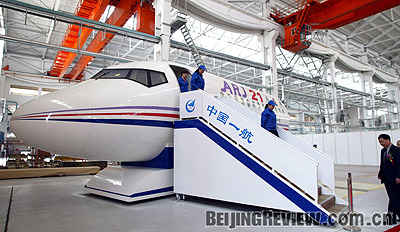|

LOFTY AMBITIONS: China is flying toward its goal of large aircraft manufacturing with a 90-seat regional jet called the ARJ21, rolled out in December 2007
Martin Craigs, President of Aerospace Forum Asia, told the Wall Street Journal this March that money and ambition alone will not, in the short term, create in China what took around 20 years at Airbus-a true global competitor to Boeing. But Martin probably had missed out on what else the Chinese people do have-the resolution to make the attempt.
Defying skeptics about its aerospace ambitions, China inaugurated its first company to build large passenger aircraft on May 12 in Shanghai, a stride forward toward its ultimate goal.
The new firm, named Commercial Aircraft Corp. of China Ltd. (CACC), will take charge of researching, developing, manufacturing and marketing the aircraft.
The new firm has a registered capital of 19 billion yuan ($2.7 billion), with the State-owned Assets Supervision and Administration Commission investing 6 billion yuan ($857.1 million), as its largest shareholder.
Other stakeholders include Shanghai Guo Sheng (Group) Co. Ltd., China Aviation Industry Corp. I (AVIC I), AVIC II, Aluminum Corp. of China, Baosteel Group Corp. and Sinochem Corp.
Zhang Qingwei, former Minister of the Commission of Science Technology and Industry for National Defense (COSTIND), was appointed board chairman of the company, while COSTIND Vice Minister Jin Zhuanglong was appointed general manager.
Large aircraft refers to aircraft with a load capacity exceeding 100 tons. Used for both military and civilian purposes, they include cargo and passenger carriers with 200 seats. Currently, constructing large aircraft is mainly confined to the United States, Russia and a few European countries, with Boeing and Airbus dominating the international markets.
"The nascent company needs a long time to surmount technology obstacles and develop professionals. It's too early to lay out a timetable for flying a large jet," said Jin in an interview with Xinhua News Agency.
However, people close to the situation disclosed that China is hopeful to launch its first large aircraft by 2020 if everything progresses smoothly.
According to Jin, the most urgent task facing CACC is the delivery of ARJ21, the first homegrown regional jet, after which production of China's large aircraft may be modeled.
Putting in place an operating system for civil aircraft research and doubling efforts on training of professionals have also been put on the agenda, added Jin.
"Since the 1970s, China has sought to develop civil aircraft, first by itself, then through means of subcontracting and cooperation. All the efforts have virtually ended in failure, either because the planes made could not match the clients' needs, or China did not own independent intellectual property rights," Liu Gaozhuo, President of AVIC I ,was quoted by China Daily as saying.
"CACC aims to become a large aircraft producer with independent intellectual property rights. But that does not hamper our readiness to embrace international cooperation," said Jin.
As a matter of fact, production of at least 50 percent of the aircraft parts will have to rely on foreign bidders, according to Zhou Jisheng, Vice General Designer of ARJ21.
As air travel has boomed domestically in recent years, China is hard pressed by the swelling demand. The past 20 years have seen the market demand of Chinese civil aviation bulge over 8 percent annually. It's even projected that China will become the second largest civil aircraft market only after the United States.
Chinese airlines operated 1,150 commercial aircraft in 2007, and Boeing forecasts they will need 3,310 additional jetliners by 2026.
Since 1972, China has paid a total of $29.2 billion for the 523 aircraft it has purchased or rented from Boeing. China will have to reach deeper into its pockets for the rising demand of air services.
As a result, supplying its own large aircraft can moderate the excessive reliance on foreign giants, such as Airbus and Boeing, and become a catalyst for the development of the Chinese aviation industry.
Long before China made any substantial moves, foreign media had raised fears that China would rise to a forceful competitor to Boeing and Airbus. The Associated Press and Agence France Presse said CACC would rival the monopoly of Airbus and Boeing by producing 150 large jets by 2020.
However, Jin lashed out against rumors that CACC will cast shadow over the development of Airbus and Boeing. "We still have a long way to go before posing a real threat to the international heavyweights," said Jin. | 